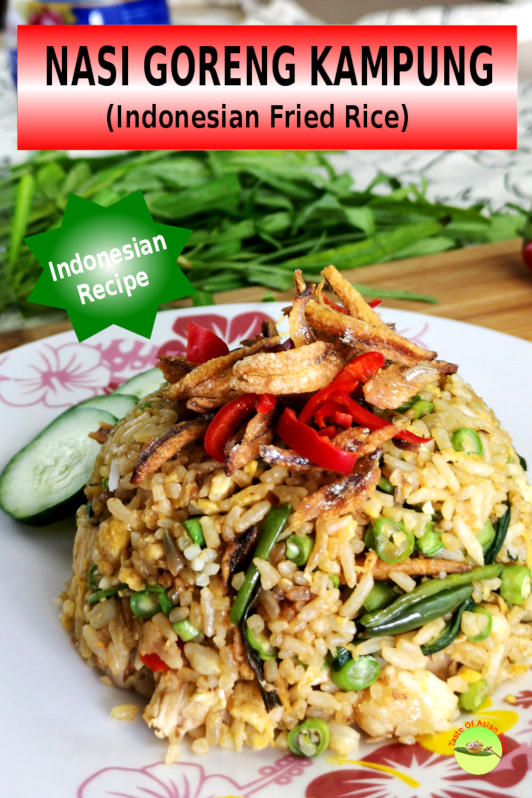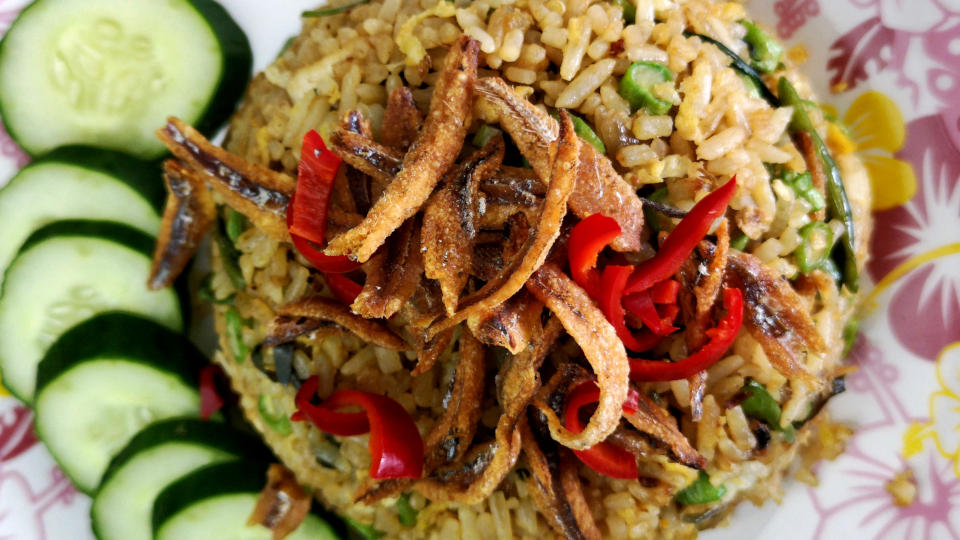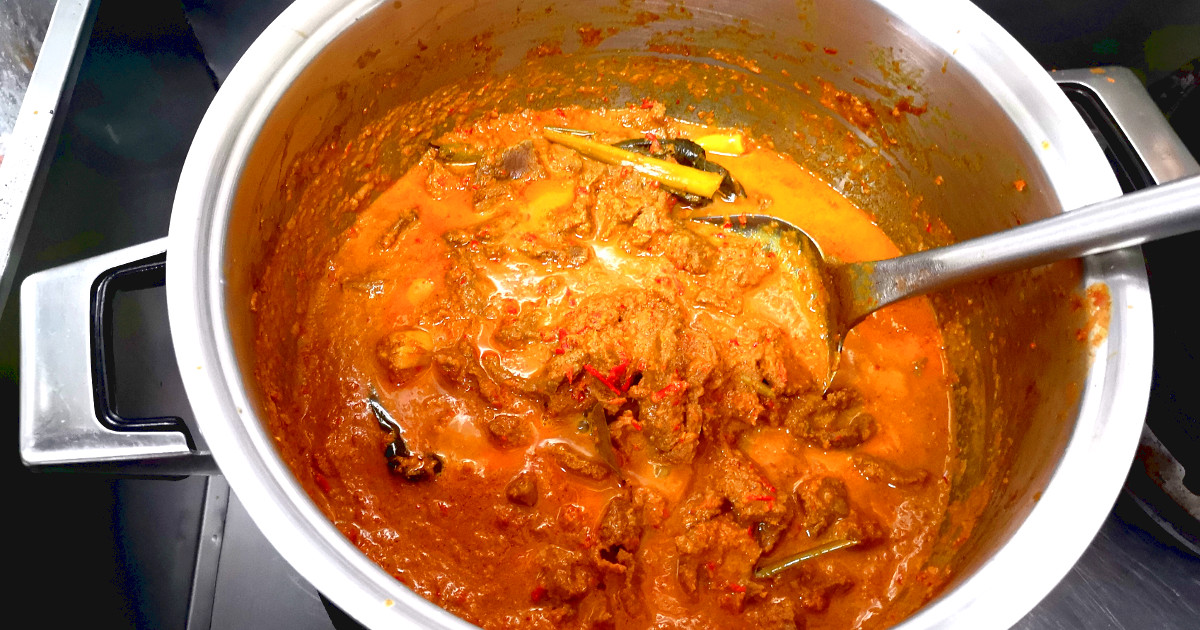If you enjoy fried rice, you simply cannot miss the Indonesian and Malay versions known as nasi goreng.
What is Nasi Goreng?
Nasi goreng translates to “fried rice” in both Indonesian and Malay. This beloved dish is prepared using a chili paste made from bird’s-eye chili, shallots, garlic, belacan (a local shrimp paste), and anchovies. It is the most cherished fried rice variety throughout Southeast Asia.
In this article, we will explore how to prepare the Malaysian version of nasi goreng, known as nasi goreng kampung (village fried rice). This dish boasts a unique flavor profile that sets it apart from other Asian and Chinese fried rice recipes, thanks to its use of chili paste, kangkung (water spinach), and ikan bilis (anchovies).
Nasi goreng kampung is a delightful, spicy gem of Indonesian cuisine. Let’s delve into the details!

How to Prepare Nasi Goreng Kampung
1. Prepare the Chili Paste
The Components of the Chili Paste
The chili paste is a vital element of nasi goreng, combining chili, shallots, and garlic, along with optional ingredients like shrimp paste (belacan) and tamarind juice (asam java). Let’s examine these ingredients one by one.
Chili
The most common chili used for this paste is the bird’s-eye chili (chili api), which is small, about two inches long, and comes in red and green varieties. The term ‘api’ means fire, indicating its intense heat, measuring around 50,000 – 100,000 Scoville heat units, significantly hotter than jalapeños.
An alternative is the serrano chili, which is milder. Some recipes incorporate a mix of serrano, bird’s-eye, and dried red peppers. If you cannot find these, cayenne pepper and chili flakes are suitable substitutes.
Shallots and Onions
Both shallots and onions can be used to create the chili paste. Restaurants often opt for onions due to their cost-effectiveness and ease of preparation. Onions are larger and quicker to peel and chop, which is crucial for saving time in a restaurant setting.
Shallots are better suited for grinding with a mortar and pestle, while onions are more convenient when using a food processor.
Other Ingredients
The essential components for the chili paste are chili, onion/shallot, and garlic, while belacan and tamarind juice are optional.
Belacan is a fermented shrimp paste that adds a strong umami flavor. It should be used sparingly due to its potent taste and aroma, which is quite distinct. While you can omit it if unavailable, it is highly recommended for enhancing the dish’s flavor.
Tamarind is also used in some nasi goreng kampung recipes. It is prepared by soaking tamarind pulp in hot water, lending a sour note to the dish. However, it can be omitted if sourness is not preferred.
The Use of Blender vs. Mortar and Pestle
Some cooks prefer using a mortar and pestle to prepare the chili paste, believing that nasi goreng kampung is a traditional recipe best made manually. They argue that a blender produces a finer paste, which lacks the authentic texture.
To compare, I prepared the chili paste using both methods and cooked two plates of nasi goreng to taste the differences. I received positive feedback from some Indonesians who tried both versions. While both methods yield excellent results, I personally prefer using a mortar and pestle for small batches, as it saves time on cleanup.
2. How to Make Crispy Fried Anchovies
Ikan bilis (anchovies) are a key ingredient in nasi goreng, used in both the chili paste and as a topping. To achieve the best results, the anchovies should be deep-fried until crispy. Here’s how:
- Remove the heads and gills. While some may skip this step, taking the time to do so results in a more elegant presentation.
- Rinse the anchovies with water to remove any potential contaminants, such as sand.
- Drain and pat dry with paper towels, spreading them in a single layer to ensure they are thoroughly dry before frying.
- Heat about 1/4 inch of cooking oil in a wok. Suitable oils include corn, peanut, or palm oil, which have neutral flavors and high smoke points. Avoid olive oil, as its flavor can affect the dish.
- Fry the anchovies in hot oil (around 190°C/375°F), stirring constantly with chopsticks.
- Fry for about one minute, or until the oil stops sizzling and bubbling, indicating they are done.
- Remove the anchovies and let them cool on a kitchen towel to absorb excess oil. You can prepare a larger batch and store them in an airtight container for later use.
3. Can I Use Other Vegetables Instead of Kangkung?
Kangkung is essential for authentic nasi goreng kampung. However, if you cannot find it or prefer not to use it, you can substitute it with other leafy vegetables, such as choy sum, which is commonly found in Asia. Long beans are another popular ingredient; simply cut them into short sections and stir-fry them with the rice.
4. How to Prepare Cooked Rice
For the best results in fried rice, I recommend using overnight cooked rice, as it is less sticky and easier to manage. If you need to cook fresh rice, use less water to achieve a drier consistency. You can also spread the cooked rice on a tray and let it cool under a fan to dry it out further. Ensure to separate any clumped rice grains before frying.
5. Detailed Stir-Frying Process
Once you have prepared the anchovies and chili paste, you can complete nasi goreng kampung in just five minutes.
Before Adding the Rice
- Heat some cooking oil in the wok, using leftover oil from frying the anchovies for added flavor.
- Add the chili paste to the hot oil and sauté over low heat until aromatic.
- Add your choice of meat (I use diced chicken breast) and stir-fry over low heat before increasing to medium heat as it cooks.
- You can either remove the chicken and chili paste from the wok or add the cooked rice and eggs directly. I prefer to remove them first to allow the rice to have direct contact with the hot wok, enhancing aroma and preventing clumping.
After Adding the Rice
- Add the rice to the wok, stirring over low heat initially. As the rice dries, you can increase the heat without fear of sticking.
- Push the rice to the side and scramble two eggs in the wok until half cooked, then mix them with the rice.
- Return the chili paste and chicken to the wok, adding the long beans and kangkung. Season with sweet soy sauce (kecap manis), sugar, salt, and pepper.
- Stir-fry on high heat until the kangkung wilts, then garnish with spring onions if desired.
- Serve topped with a generous spoonful of fried anchovies, alongside prawn crackers (keropok) and a fried egg.
What If I Don’t Have a High-Power Stove?
If you don’t have a high-power stove like those in restaurants, you can still achieve great results:
- Cook in small batches to maintain heat in the wok or pan.
- Use a large frying pan if you don’t have a wok; it won’t affect the outcome.
- Ensure the pan or wok is hot before adding the rice.
Conclusion
Nasi goreng, or Indonesian fried rice, is immensely popular in Southeast Asia, especially among those who enjoy spicy flavors. Its unique taste distinctly sets it apart from any Chinese fried rice.
If you love fried rice, you might also want to try the famous Chinese variant, Yang Chow fried rice. And for those who appreciate Indonesian cuisine, don’t miss out on Indonesian rendang Minang.
Ingredients
Ingredients for Paste (A)
- 4 cloves garlic
- 1 tbsp fried anchovies
- 10g (0.3 oz) of belacan
- 6 bird’s-eye chili (red and green mix)
- 4 shallots, about 40g
Other Ingredients (B)
- Cooking oil
- 60g (2 oz) kangkung (water spinach)
- 50g (1.75 oz) long beans
- 10g (0.3 oz) ikan bilis (about one handful)
- 100g (3 oz) chicken breast meat, cut into dice
- 2 eggs
- 300g (10 oz) cooked rice
Seasoning (C)
Recommended Products
As an Amazon Associate and member of other affiliate programs, I earn from qualifying purchases.
Nutrition Information:
Yield: 2 servings
Serving Size: 1
Amount Per Serving:
Calories: 2208
Total Fat: 117g
Saturated Fat: 35g
Trans Fat: 0g
Unsaturated Fat: 54g
Cholesterol: 525mg
Sodium: 7487mg
Carbohydrates: 155g
Fiber: 12g
Sugar: 27g
Protein: 135g
This data was provided and calculated by Nutritionix on 4/30/2020





